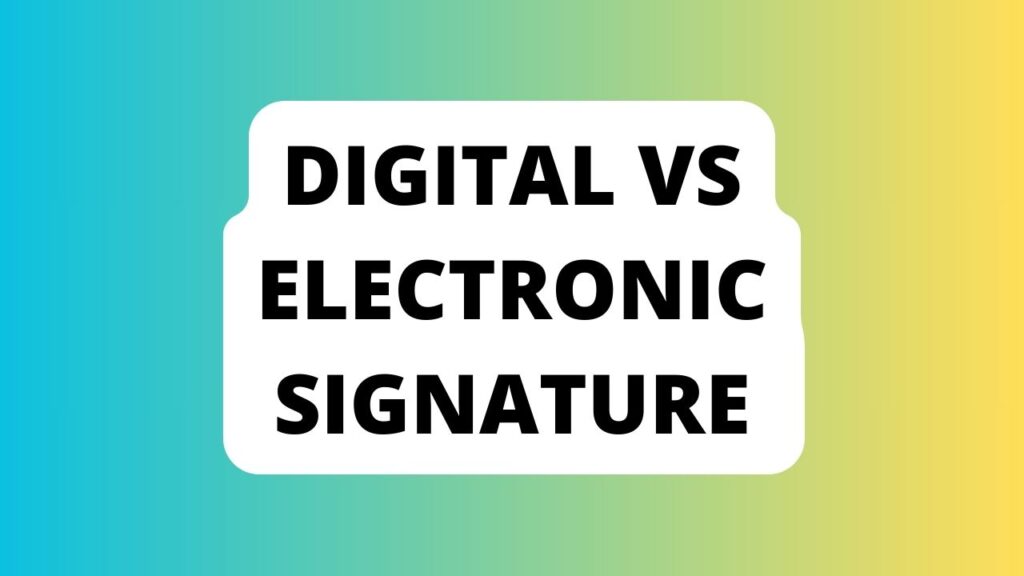Introduction
Digital vs Electronic Signature In the realm of modern documentation, the terms “digital” and “electronic” signatures often intermingle, leading to confusion. Understanding the nuances between these two is pivotal. Digital signatures and electronic signatures both streamline the signing process, but their methodologies diverge significantly.
Defining Digital Signatures
Digital signatures employ cryptographic techniques to authenticate the signer’s identity and validate the document’s integrity. These signatures use a unique digital fingerprint, binding the signer to the document in a tamper-evident manner.
Understanding Electronic Signatures
On the other hand, electronic signatures encompass a broader spectrum, encompassing any electronic indication of intent to agree to the content or terms of a document. Unlike digital signatures, electronic signatures aren’t necessarily reliant on encryption.
Key Characteristics
Security Features: Digital signatures boast advanced security measures like encryption and timestamping, ensuring data integrity and authenticity.
Legal Validity: Both digital and electronic signatures hold legal validity in many jurisdictions, but the level of acceptance may vary.
Use Cases: Digital signatures are prevalent in fields requiring stringent security, such as banking and legal documents. Electronic signatures find utility in a broader range of everyday applications.
Pros and Cons
Advantages of Digital Signatures: Their robust security measures make them ideal for sensitive documents, reducing the risk of fraud and ensuring compliance.
Advantages of Electronic Signatures: They offer convenience and accessibility, simplifying workflows and accelerating processes.
Limitations of Digital Signatures: Implementing digital signatures can require specific infrastructure and technical expertise.
Limitations of Electronic Signatures: Some industries might not readily accept electronic signatures due to legal or regulatory reasons.
Implementations
Business Applications: Digital signatures revolutionize business processes, expediting contract signings, approvals, and compliance procedures.
Personal Usage: Electronic signatures cater to personal needs like signing leases, agreements, or forms digitally, eliminating paper-based hassles.

Electronic Signatures
Distinguishing themselves, electronic signatures encompass a broader spectrum. Unlike digital signatures, they don’t rely on encryption but serve as an electronic indication of intent to sign or approve a document. They can take various forms like scanned images of handwritten signatures, tick boxes, or typed names.
Benefits of Both Signatures
The benefits of digital and electronic signatures are multifaceted. Speedy processing, reduced paperwork, cost savings, and environmental impact reduction are among the advantages they offer.
Challenges & Limitations
However, challenges such as technological barriers, regulatory complexities, and user trust pose hurdles to their widespread adoption. Ensuring interoperability and overcoming these limitations remain critical.
Future Trends
The future of signatures is poised for further innovation. Advancements in biometrics, blockchain integration, and AI-driven authentication promise to revolutionize signature technologies.
Case Studies
Real-world examples highlight the effectiveness of digital and electronic signatures. Case studies across industries demonstrate enhanced efficiency, reduced turnaround times, and heightened security.
FAQs
Are digital signatures and electronic signatures the same? No, they differ in their fundamental mechanisms and security approaches. Digital signatures use cryptographic keys, whereas electronic signatures encompass broader forms of electronic acknowledgment.
Are digital signatures legally binding? Yes, digital signatures hold legal weight in many jurisdictions globally. They adhere to stringent authentication and encryption standards, ensuring their validity.
What are the primary security features of digital signatures? Digital signatures rely on complex encryption algorithms, ensuring document integrity, signer authentication, and non-repudiation.
Can electronic signatures be as secure as digital signatures? While electronic signatures lack the cryptographic complexity of digital signatures, they can be secure when utilizing robust authentication and verification methods.
Which industries benefit the most from these signatures? Industries like finance, healthcare, real estate, and legal services benefit significantly, streamlining processes and improving efficiency.
How do these signatures contribute to sustainability? By reducing paper usage and expediting processes, digital and electronic signatures contribute to environmental conservation efforts.
Conclusion
The evolution from traditional signatures to digital and electronic counterparts marks a transformative leap in how we authenticate and authorize documents. Understanding their differences, benefits, and challenges is pivotal in leveraging their potential to drive efficiency, security, and compliance across industries.
